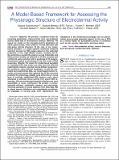A Model-Based Framework for Assessing the Physiologic Structure of Electrodermal Activity
Author(s)
Subramanian, Sandya; Purdon, Patrick L; Barbieri, Riccardo; Brown, Emery N
DownloadPublished version (7.045Mb)
Publisher with Creative Commons License
Publisher with Creative Commons License
Creative Commons Attribution
Terms of use
Metadata
Show full item recordAbstract
OBJECTIVE: We present a statistical model for extracting physiologic characteristics from electrodermal activity (EDA) data in observational settings. METHODS: We based our model on the integrate-and-fire physiology of sweat gland bursts, which predicts inverse Gaussian (IG) inter-pulse interval structure. At the core of our model-based paradigm is a subject-specific amplitude threshold selection process for EDA pulses based on the statistical properties of four right-skewed models including the IG. By performing a sensitivity analysis across thresholds and fitting all four models, we selected for IG-like structure and verified the pulse selection with a goodness-of-fit analysis, maximizing capture of physiology at the time scale of EDA responses. RESULTS: We tested the model-based paradigm on simulated EDA time series and data from two different experimental cohorts recorded during different experimental conditions, using different equipment. In both the simulated and experimental data, our model-based method robustly recovered pulses that captured the IG-like structure predicted by physiology, despite large differences in noise level. In contrast, established EDA analysis tools, which attempted to estimate neural activity from slower EDA responses, did not provide physiological validation and were susceptible to noise. CONCLUSION: We present a computationally efficient, statistically rigorous, and physiology-informed paradigm for pulse selection from EDA data that is robust across individuals and experimental conditions, yet adaptable to varying noise level. SIGNIFICANCE: The robustness of the model-based paradigm and its physiological basis provide empirical support for the use of EDA as a clinical marker for sympathetic activity in conditions such as pain, anxiety, depression, and sleep states.
Date issued
2021Department
Harvard University--MIT Division of Health Sciences and Technology; Picower Institute for Learning and Memory; Massachusetts Institute of Technology. Institute for Medical Engineering & ScienceJournal
IEEE Transactions on Biomedical Engineering
Publisher
Institute of Electrical and Electronics Engineers (IEEE)
Citation
Subramanian, Sandya, Purdon, Patrick L, Barbieri, Riccardo and Brown, Emery N. 2021. "A Model-Based Framework for Assessing the Physiologic Structure of Electrodermal Activity." IEEE Transactions on Biomedical Engineering, 68 (9).
Version: Final published version